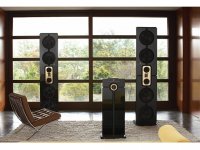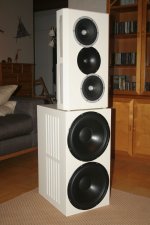these are a build for a friend, his funding.
probably all Peerless drivers, nomex 8", nomex 5" and 921 tweeter.
What are the reason for choosing WMTMW or MTMWW ?
May try to do the mids open back.
probably all Peerless drivers, nomex 8", nomex 5" and 921 tweeter.
What are the reason for choosing WMTMW or MTMWW ?
May try to do the mids open back.
Properly executed, a WMTMW can do a very good job at reproducing a square wave. The height makes a statement in the listening room.
http://www.musicanddesign.com/icta.html
http://www.steinwaylyngdorf.com/Model_D-45.aspx
Properly constructed, a MTMWW can be low enough in height to not dominate the listening room. The square wave transient response will have some compromises. A TMWW using a larger diameter M like the Linkwitz Orion dipole is a more common design because of its lower height.
http://www.musicanddesign.com/icta.html
http://www.steinwaylyngdorf.com/Model_D-45.aspx
Properly constructed, a MTMWW can be low enough in height to not dominate the listening room. The square wave transient response will have some compromises. A TMWW using a larger diameter M like the Linkwitz Orion dipole is a more common design because of its lower height.
Attachments
Hi Andy, both can work well. I always prefer to use WMTMW. This is a point source array at all frequencies and allows you to use any xover points. If using MTMWW then you must keep the mid to woofer xover point below about 100Hz or so to help with imaging. Most speakers are not made like this for one simple reason $$$$$$$$$$$!
Terry
Terry
I'm unconvinced that, given the wavelengths involved, there's any difference in the point source characteristics. BUT... there is a difference in the response notch due to floor bounce.
I'm unconvinced that, given the wavelengths involved, there's any difference in the point source characteristics. BUT... there is a difference in the response notch due to floor bounce.
Hi Sy,
A lot depends on the slopes of the xover. Point source with 1st order xovers always sound and measure better in WMTMW. If you take that as read then it will also be better with higher order but you may not hear a difference. Depends on your ears.

To reproduce good squarewave response in this WMTMW setup, do the crossover have to be low orders, maybe even 1 order to make it work well? If you want good squarewave response?
How do you test this, can a Clio meassuring program or similar do this, or do you use a tonegenerator and a mic?
How do you test this, can a Clio meassuring program or similar do this, or do you use a tonegenerator and a mic?
To reproduce good squarewave response in this WMTMW setup, do the crossover have to be low orders, maybe even 1 order to make it work well? If you want good squarewave response?
How do you test this, can a Clio meassuring program or similar do this, or do you use a tonegenerator and a mic?
I am not being a smart a**e when I say this but I don't listen to square waves. I often listen to square music as my sons always tell me.
For a speaker to faithfully reproduce music you have to count everything as important. 1st order puts way less parts in the audio path, is easy to impliment but, the caveat is, the drivers have to like each other.
Driver selection is the most important part of a design. Get that right and the rest is fun. Get two drivers that don't get on well and you will have a bit** of a time designing the crossover.
Terry
1st order puts way less parts in the audio path, is easy to impliment but, the caveat is, the drivers have to like each other.
It also screws up polar pattern and increases distortion in pursuit of a goal which is questionable at best. It's actually quite difficult to implement, at least if you want an actual 1st order crossover, not just an electrical circuit that looks like one- see some of Thiel's speakers, for example. Those crossovers are VERY complex.
Hi Sy,
A lot depends on the slopes of the xover. Point source with 1st order xovers always sound and measure better in WMTMW. If you take that as read then it will also be better with higher order but you may not hear a difference. Depends on your ears.
The crossover will almost certainly be a 1st order (electrical) linked series x-o. Hence the choice of drivers.
The 'client' has heard all of the speakers that I have hooked up here and really likes the sound, (but none suit his decore, darn).
To reproduce good squarewave response in this WMTMW setup, do the crossover have to be low orders, maybe even 1 order to make it work well? If you want good squarewave response?
How do you test this, can a Clio meassuring program or similar do this, or do you use a tonegenerator and a mic?
To reproduce a square wave, you need to have a tweeter that can go really high, and pretty darn good phase coherance through the double x-o points.
(gotta love them fourier series 😉 )
If using MTMWW then you must keep the mid to woofer xover point below about 100Hz or so
If I want to go OB with the mids, this becomes a real issue. !!
It also screws up polar pattern and increases distortion in pursuit of a goal which is questionable at best. It's actually quite difficult to implement, at least if you want an actual 1st order crossover, not just an electrical circuit that looks like one- see some of Thiel's speakers, for example. Those crossovers are VERY complex.
Sy, If you have that many problems then choose drivers for their relationship to each other rather than selecting them just because they are good drivers.
Terry
Which one you would prefer of Zaph's ZA5.5tt, MMTMM or MTMMM ?
http://www.zaphaudio.com/ZA5/
I think XO point for 0.5 is quite high (BSC) so MMTMM would be better? Is there risk that image falls to floor if there's MMM below tweeter?
http://www.zaphaudio.com/ZA5/
I think XO point for 0.5 is quite high (BSC) so MMTMM would be better? Is there risk that image falls to floor if there's MMM below tweeter?
Which one you would prefer of Zaph's ZA5.5tt, MMTMM or MTMMM ?
http://www.zaphaudio.com/ZA5/
I think XO point for 0.5 is quite high (BSC) so MMTMM would be better? Is there risk that image falls to floor if there's MMM below tweeter?
I would not use an MTMMM array. It will stuff up about an octave either side of the xover point.
Terry
I would not use an MTMMM array. It will stuff up about an octave either side of the xover point.
Terry
OK. So only pro for MTMMM is less taller enclosure with same tweeter height?
I am considering to start building ZA5.5tt MMTMM but maybe change tweeter for SS HDS-1 and tune XO for it.
Tweeters:
http://www.madisound.com/catalog/PDF/DQ25SC05-04.pdf
http://www.madisound.com/catalog/PDF/d2608-913000.pdf
OK. So only pro for MTMMM is less taller enclosure with same tweeter height?
I am considering to start building ZA5.5tt MMTMM but maybe change tweeter for SS HDS-1 and tune XO for it.
Tweeters:
http://www.madisound.com/catalog/PDF/DQ25SC05-04.pdf
http://www.madisound.com/catalog/PDF/d2608-913000.pdf
Yea, I intensly dislike metal dome tweeters. A Morel DMS37 could work well.
Terry
Yea, I intensly dislike metal dome tweeters. A Morel DMS37 could work well.
Terry
hmmm me too! I hate metal domes! They sound very unnatural (and "present") to me... Strangely I also chose Morel DMS37's for my project, and really liked them in my prototype... just need to get the project finished so I can enjoy them again! My current speakers have phiilips AD11600/T8 Tweeters, which have some sort of doped cloth domes, whilst not fantastic to me they sound a lot nicer than any speaker I have heard with metal dome tweeters, some of which were MUCH more expensive.
Tony.
I have had 6 pairs of Epos speaker. All of with metal domes. They are not bad. Heard much worse soft domes.
EDIT: Tony, I didn't mean to start any fight.🙂 I just believe that design of tweeter is more important than material of dome. And design of loudspeaker is even more important than material of dome.🙂 I never align speakers straight to ear, often(always) parallel to the side walls. So ultra high resonance is not audible if it even will be with any different alignment.
EDIT: Tony, I didn't mean to start any fight.🙂 I just believe that design of tweeter is more important than material of dome. And design of loudspeaker is even more important than material of dome.🙂 I never align speakers straight to ear, often(always) parallel to the side walls. So ultra high resonance is not audible if it even will be with any different alignment.
Last edited:
I have had 6 pairs of Epos speaker. All of with metal domes. They are not bad. Heard much worse soft domes.
Yep that's the interesting thing, and shows how subjective (and how different) (edit: subjective may not be the right word) peoples own preferences can be 🙂 Though we are getting off topic.. Didn't want to start a religious war on soft vs metal domes! 🙂 A good mate of mine absolutely loved one of the more expensive vifa metal domes and I couldn't stand them. No speaker is perfect, I guess different people are more sensitive to different flaws 🙂
Back on topic, I'd say (purely speculatively) the most important thing to consider in the decision for WMTMW or MTMWW would be what crossover the W-M crossover freq is going to be... if it is low enough then I don't think there will be any disadvantage to the WW (and possibly the advantage of floor re-inforcement) , but if it was higher then integration might suffer.. Then again maybe the WMTMW could give some advantages in the midrange reducing floor and ceiling relfections due to the same effects that a plain MTM gives?? (regardless of how low the cross to the woofers is...
I said speculatively because I really don't know! 🙂
Tony.
Last edited:
Sy, If you have that many problems then choose drivers for their relationship to each other rather than selecting them just because they are good drivers.
Terry
I may also spend time wondering about how best to cash in the gold bars that may fall off a passing zeppelin.
There's a reason that skilled pros (like Thiel) who use acoustic 6dB crossovers end up with complex and expensive crossovers. I'm no pro, but I've built a pretty fine speaker designed along those lines (but it was a 5 way). So I have a fair understanding of the challenges of trying to achieve a first order crossover. And because of the complication of these designs, they succeed despite the handicap of a crossover chosen because of philosophy rather than data.
The square wave notion has a problem- it's only a square wave for one point in space. To achieve something better than that, you need more exotic solutions like the Quad ESL63. Not that square wave accuracy (and the measure of that is, ahem, flexible) is necessarily important from the standpoint of human hearing...
- Status
- Not open for further replies.
- Home
- Loudspeakers
- Multi-Way
- pros and cons.. WMTMW vs MTMWW ?

